William Pitsenbarger
 During the Vietnam War,
During the Vietnam War, 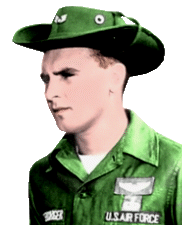 the United States Air Force awarded its second-highest award, the Air Force Cross, to nineteen enlisted airmen. Of those nineteen awards, ten were awarded to Pararescuemen.... better known as PJs.
the United States Air Force awarded its second-highest award, the Air Force Cross, to nineteen enlisted airmen. Of those nineteen awards, ten were awarded to Pararescuemen.... better known as PJs.
The Pentagon is a mighty big place, an American institution filled with legends, lore, and high-ranking military men and women. For Mr. and Mrs. William Pitsenbarger, the September 22, 1966 visit to the home of America's military men and women had all the elements of culture shock. It was like walking into a whole new world, a world separated from their small hometown of Piqua, Ohio by more than miles. Calming their uneasiness and fighting to overcome the emotions that struggled for release, the brave couple found themselves being introduced to the US Air Force Chief of Staff, General John P. McConnell. Standing to the side to witness the events that were about to unfold was Ohio Senator Frank Lausche. Later that same afternoon the Senator would write in the Congressional Record,
"They (Mr. and Mrs. Pitsenbarger) stood there heroically, in my opinion reflecting the courageous and stalwart character of their son."
Their son...that's what this was all about. As the couple waited for the ceremony to begin, perhaps they could not avoid remembering young William Pitsenbarger's zest for life...a zeal that had always driven him to experience every adventure and push the envelope to the limits. Irene Pitsenbarger may have thought briefly about the many times her young son had given her reason for fright. Even as a lad he had flirted with danger, taking his childhood games like "follow the leader" to the ledges of the highest buildings or the limbs of the tallest trees. In his junior year of high school in his small town of 20,000, young William Pitsenbarger had tried to enlist in the Army's Special Forces to wear the coveted Green Beret. Adamantly Irene and her husband had refused to give their 17-year old permission to join the Army, requiring him to remain in school one more year to graduate.
In the Spring of 1962, William Pitsenbarger graduated from high school. He continued to work as a stock boy at the local Kroger supermarket, all the while thirsting for more adventure. While there, it was the Air Force recruiter who captured the young man's attention. On the last afternoon of the year, New Year's Eve 1962, William Pitsenbarger broke the news to his parents. He had enlisted in the Air Force and would soon be boarding a train for San Antonio to begin his training. How soon? He was leaving that very night.
In the quiet dignity of the halls of the Pentagon, the senior Pitsenbarger remembered how proud he had been of his son. Not only had he chosen to serve his country in uniform, but he had also chosen to serve among some of the most elite. After Air Force basic training, the young airman had continued to push the envelope and expand his thirst for adventure.
He trained with members of the Army at Fort Benning, Georgia to earn his jump wings. He attended the Navy's underwater swimmers’ school. He successfully completed the rescue and survival medical course. At Stead AFB, Nevada, he completed the combat survival course, at Elgin AFB in Florida he attended the Tropical Survival School, and at Albrook AFB, C.Z. he attended the fire-fighters course for the HH-43 helicopter. Through it all, he emerged as one of the Air Force's elite Pararescuemen, more commonly known as PJs.
PJs were born out of the efforts of Lieutenant Colonel Don Fleckinger and two medical corpsmen who parachuted into remote jungles near the China-Burma border in August 1943 to rescue survivors from a disabled C-46. For nearly a month the officer and his two medics had treated the injured while leading them to rescue. Among those restored to safety was Eric Severeid, who would go on to become a well-known news commentator. He described the forerunners of the Pararescue program as "Gallant".
Gallant, they were true. They were also dedicated to saving lives, not only during times of war but also in peace. The PJ motto is "That Others May Live", and the unspoken preface to their motto was that the men of this highly trained rescue force would do anything...including risking their lives to the highest degree...
"These things we do, so that others may live"
Yes, the elder Pitsenbarger was justly proud of his son. Young William had come home after his extensive training a grown man, confident that he could accomplish any task and fulfill any demands his job might require. His role had taken him to Perth, Australia as a Pararescue-medic in the earliest days of the space program, working on the Gemini and Mercury space probe recoveries.
Then had come the looming threats of conflict in Vietnam. When Airman Pitsenbarger got orders for service in the war zone in August 1965 he had only a little more than a year remaining in his 4-year Air Force enlistment. For the first time, the senior Pitsenbarger began to worry about the risks inherent in his son's military specialty. Father and son agreed not to tell Irene the full story. It would be best if she did not know that her only son would be performing some of the most dangerous missions faced by any young man in a combat zone.
Vietnam
Airman Pitsenbarger arrived in Vietnam on August 8th and was assigned to Detachment 6, 38th Air Rescue and Recovery Squadron at Bien Hoa Air Base. His unit was responsible for many different kinds of rescue missions, from recovering downed pilots to evacuating wounded airmen or soldiers for both the US military units as well as South Vietnamese units. Detachment 6 consisted of five aircrews that flew three HH-43F Kaman Huskie helicopters. The Air Force rescue craft with their twin rotors was not as trim in appearance as the "Dustoffs" used by the Army for evacuating their own wounded. But the Huskies had a unique advantage. The "Dustoffs" could only retrieve wounded soldiers by landing on the ground...a limitation all too common in the Southeast Asian war zone famous for dense, triple-canopy jungles. The Air Force Huskies could hover over the last layers of the jungle foliage and winch a wire-mesh Stokes Litter to those on the ground. When a wounded man had been properly strapped inside the litter, he could then be winched up into the Huskie where Pararescue medics like William Pitsenbarger waited to administer lifesaving first aid during the flight to a field hospital.
Over the months that followed William Pitsenbarger did his best to downplay the dangers of his job in his letters home. In fact, the letters and pictures he sent back seemed to indicate that Airman Pitsenbarger was actually having a good time at the Air Base a short distance from the South Vietnamese capital city of Saigon. Pits, as the Airman from Piqua, Ohio came to be called, was a happy and likable young man. The other men in his Detachment enjoyed being around Pits. He never complained and had a great sense of humor and tendency to clown around when things were quiet.
At the same time, when things were not quiet, Pits was great to have around, especially if you were a downed airman alone in enemy-controlled jungle or a wounded soldier in the field. "All of us PJs had a strong desire to save lives," said Chief Master Sergeant Dave Milsten, the ranking Pararescueman in Detachment 6, "that's what we lived for. But Bill (Pitsenbarger) had a triple dose of that."
In the 275 days from August 8, 1965 to April 11, 1966, Airman First Class William Pitsenbarger flew more than 300 rescue missions over the jungles of Vietnam. Time and again he has faced enemy fire, stared death in the face and calmly set himself to the tasks of a Pararescue medic. Hundreds of men owed their lives to a young medic called Pits...and not only for his lifesaving first aid in the airborne trip from the jungle to a field hospital. Time and again, as was not uncommon among any of the dedicated PJs, Pits had made the ascent from the relative shelter of his hovering Huskie to the jungle floor to render immediate first aid to wounded and then strap them into the lowered Stokes Litter.
On March 7th Pits' aircrew flew on a mission to rescue a wounded South Vietnamese soldier who had walked into an old minefield while fighting a fire. The man had lost his foot when he stepped on a mine and was trapped inside a maze of old and unstable explosive devices. As Pits' Huskie began the approach, a plan for extracting the wounded man without detonating other mines in the field had to be devised. Pits' solution? "Lower me down on the penetrator (a rudimentary seat lowered by cable from a hovering helicopter) and I'll straddle the guy. Pick him up, and then you can lift me up." Heedless of the potential for disaster should the heavy prop wash of the Huskie's twin-blades detonate other mines in the field, Airman Pitsenbarger made the ascent, snatched the wounded soldier, and restored him to safety.
For that selfless act of heroism, Pits was awarded the highly regarded Airman's Medal by the United States Air Force. The government of South Vietnam awarded him Vietnam's Medal of Military Merit and the Gallantry Cross with Bronze Palm. Time and again these brave medics had been inserted to save lives. But the choice to "go in" was always a voluntary call, made the PJs themselves. When the mission called for such acts of personal courage, there was never a shortage of volunteers.
The Air Force Cross
Irene Pitsenbarger did her best to push the memories momentarily aside and stand stoically next to her husband. The elder Pitsenbarger struggled with his own emotions, unable any longer to restrain the tears. In addition to the Airman's Medal and the Vietnamese awards, their son had received the Purple Heart and six Air Medals with four more pending. And now, here at the Pentagon, Mr. and Mrs. Pitsenbarger would receive one more award on behalf of their son. Slowly, the citation was read:
"A1c William H. Pitsenbarger distinguished himself by extraordinary heroism in connection with military operations against an opposing armed force near Cam My, the Republic of Vietnam on 11 April 1966. On that date, Airman Pitsenbarger was a rescue and survival specialist aboard a helicopter engaged in the evacuating of American casualties in a dense jungle. With complete disregard for his personal safety, Airman Pitsenbarger voluntarily rode a rescue hoist more than one-hundred feet to the ground and organized and coordinated rescue efforts at the scene. During the rescue operation, he cared for and prepared the casualties for evacuation, and insured that the recovery operation continued in a smooth and orderly fashion. Following the recovery of the ninth casualty, the rescue aircraft hovering overhead was damaged and disabled by automatic weapon fire. The helicopter was forced to abandon recovery efforts to make an emergency landing at a nearby airstrip. Airman Pitsenbarger volunteered to remain on the ground and administer medical treatment to the wounded. Shortly after rescue efforts were interrupted, the area came under heavy sniper and mortar fire. Airman Pitsenbarger repeatedly exposed himself to intensive automatic fire while gathering rifles and ammunition from fallen comrades which he passed among the defenders. His bravery and determination int he faces of overwhelming odds are in keeping with the highest standards of performance and traditions of the American fighting man under attack."
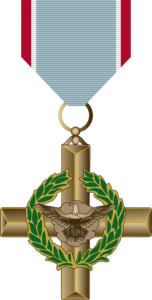
William and Irene Pitsenbarger looked with reverence at the medal presented to them by General McConnell on behalf of their son. It was the Air Force Cross, our Nation's second-highest award for military valor by a member of the United States Air Force. Their only son, Pararescue-medic William Pits Pitsenbarger had just made history...becoming the first enlisted Airman in history to receive the Air Force Cross...posthumously.
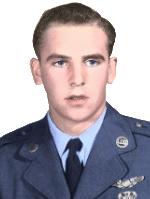 "The mother was brave. The father shed tears. But both were proud." Wrote Senator Lausche in his Congressional Record account of that day. "At the conclusion of the award, I felt that I was spiritually cleansed and fortified for a better rendition of service in the responsibility which I have for my government."
"The mother was brave. The father shed tears. But both were proud." Wrote Senator Lausche in his Congressional Record account of that day. "At the conclusion of the award, I felt that I was spiritually cleansed and fortified for a better rendition of service in the responsibility which I have for my government."
In the years that followed the 1966 presentation of the Air Force Cross to Mr. and Mrs. Pitsenbarger just five months after the death of their son, the name William Pits Pitsenbarger became synonymous with the proud traditions of sacrifice and service of the Air Force Pararescuemen. Air Force buildings were named for him, and the Air Force Sergeants Association introduced an annual award for valor in honor of the heroic actions reflected in his award citation. In time, Pits became an Air Force legend... not so much for what his citation said about his actions that day in April 1966, but for the details, it did not include!
Operation "Abilene" and the PJ's (April 10-12, 1966)
BINH GIA, Vietnam (AP)
"It was horrible," said Pfc Ronald Haley, as he stood in the tiny clearing blasted from the jungle so that the dead and wounded could be evacuated. "I've never heard such screaming in my life. Many of the wounded were yelling for their mothers. Some of the kids were calling for God." said Haley, one of the few survivors.
Haley, of Ukiah, Calif., was dirty and unkept after his unit had been in the jungles 30 miles east of Saigon for two weeks searching for the Viet Cong. The U.S. 1st Division Infantrymen found them Monday afternoon and in the bitter fight perhaps a third or more of their company were killed or wounded.
The company commander, Capt. William Nolen of Florence, S.C. described how the battle involving his "Big Red One" troops developed. He was wounded twice.
The company, part of the 2nd Battalion, 16th Regiment was moving through the jungle’s northeast of Binh Gia on a routine-patrol. At noon sniper fire began. "After a while," Nolen said, "heavy fire started coming in. We moved into a perimeter. In this first part of the fight that lasted from 45 minutes to an hour, we took quite a few casualties. The Viet Cong withdrew and we called in artillery fire. An Air Force rescue helicopter came over and lowered a ladder. They hauled out about a dozen of our wounded. Suddenly we started receiving fire from all around. There were mortars coming in, heavy machinegun fire. We were completely surrounded."
The Viet Cong were everywhere. An estimated battalion of the enemy from the main force regiment was involved. First Lt. Kenneth Anderson, of Nashville, Tenn. said snipers kept firing from the trees. "One of my boys picked up a grenade and charged one of the trees. He was killed. I saw another lieutenant running from tree to tree looking for Viet Cong positions. He was hit seven times before he was finally killed," he said.
At times, the Americans fought the enemy hand to hand.
one moves westward towards Saigon. Here the jungle grows in layers, often triple-canopy (3-layers) of heavy vegetation. So thick is the top layer, often rising over 150 feet upwards, that sunlight never reaches the vegetation at ground level. During the brightest day, soldiers moving across the jungle floor can almost feel that they are moving about at night.
Operation Abilene began on April 10, 1966...Easter Sunday. Soldiers of the 1st Infantry Division, better known as "The Big Red One", began to move into the jungle between Saigon and Vung Tau in search of the enemy. Alpha, Bravo and Charlie Companies of the First Infantry's 2nd Battalion, 16th Infantry (2/16th) were seeking elements of a 400-man Viet Cong battalion. On Monday, the second day of the sweep, the rugged terrain forced Charlie Company to move outward instead of parallel to Alpha and Bravo Companies. Sporadic sniper fire picked at the men of Charlie, 2/16th throughout the day, but no one could have predicted how intense the enemy fire would become as morning gave way to afternoon.
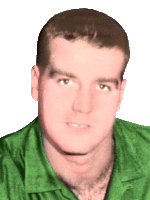
Staff Sergeant James Robinson, a former Marine, had volunteered for Vietnam duty...had, in fact, engaged in a determined year-long letter-writing campaign from his duty station in Panama in efforts to be assigned as an advisor to soldiers of the Vietnamese Army. Sergeant Robinson believed strongly in the U.S. role in Vietnam, telling his father in one letter: "There's a world on fire and we should do something about it." Now, as he led his fire-team through the dense jungles of Phuoc Tuy province, he recalled what he had written home in his most recent letter..."The price we pay for freedom is never cheap." Little did he know how expensive that price was about to become.
The first explosion came from American artillery fired in support of Operation Abilene. One round fell short, detonating in the top of the jungle canopy and raining deadly shrapnel on Sergeant Robinson's platoon. Two men were killed, twelve wounded, and the tall sergeant from Cicero, Illinois set his men to the task of clearing a landing zone for medevac choppers to extract the casualties. As the survivors hacked through the jungle vegetation, they did not realize they were only yards from their primary objective...the command post of the Viet Cong Battalion Operation Abilene sought to find and destroy.
As the infantrymen fought to reclaim enough jungle landscape for the medevacs to land, the enemy attacked with mortars and machinegun fire. Pandemonium erupted among the American soldiers as they clamored for any semblance of shelter. In the midst of sudden death and unrestrained terror, Sergeant Robinson began moving among the men to organize defensive fire and inspire confidence. Locating one highly effective enemy sniper, Robinson used a grenade launcher to end the threat. In the distance, he could see an Army medic kneeling to bandage the wounds of a wounded American infantryman. The enemy fire reached out to tear flesh and the medic fell to the ground. Realizing the two wounded men were dangerously exposed to continued enemy fire, Robinson ignored the whine of deadly missiles around him to rush into the open and drag the two wounded men to safety.
As the fighting continued to escalate, more wounded fell. Sergeant Robinson noticed another American fall ahead of his position. Rushing forward to rescue the wounded man, enemy rounds slammed into Robinson's shoulder and leg. Ignoring the pain, he dragged the wounded man to shelter, administered lifesaving first aid, and then treated his own serious wounds. While patching up his broken body he noticed the location of an enemy machinegun that had been inflicting heavy casualties on his unit. His rifle empty, Sergeant Robinson again ignored his wounds to attack.
Another Viet Cong bullet hit the intrepid soldier in the leg. The round was a tracer, igniting the trousers of his jungle fatigues. Sergeant Robinson ripped the burning uniform from his body and continued forward. At six feet, three inches tall he was an inspiring sight for the beleaguered men of his platoon. He was also a very large target. The full force of the aggressors turned their firepower on the advancing American.
Two more rounds struck flesh, ripping into Sergeant Robinson's chest and draining what little strength remained in his broken body. Somehow, through sheer force of determination, he continued forward...falling only after reaching an effective range and throwing the two grenades to destroy the enemy position. The price Sergeant Robinson paid for freedom wasn't cheap...he purchased it with his own life.
Abilene and the Pits
The worst was yet to come for Charlie Company. Normally the unit consisted of 291 men but, going into Operation Abilene, company strength was down to 134 soldiers. These men were now cut off from Able and Bravo companies and were surrounded by 400 or more enemy soldiers. Hidden by the dense jungle, the enemy was able to hide and still place effective sniper fire on the Americans. Quickly the attack escalated to intense mortar and machinegun fire throughout the entire area. Dead and wounded American boys littered the undergrowth in what was quickly becoming a massacre. Because of the thick, triple-canopy jungle, Army medevacs could not come in to retrieve the wounded...there was simply no place to land. The nearest clearing was 4 miles away. The only hope of getting the wounded out and headed for emergency field hospitals lay with the Air Force Huskies that were capable of hovering above the canopy to lower an empty stokes litter, then winch it back up with the body of a wounded strapped inside.
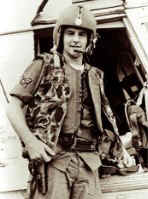 At 3 o'clock on the afternoon of April 11th, the call for help arrived at the headquarters of the 38th Aerospace Rescue and Recovery Squadron at Bien Hoa. Two Air Force Huskies were quickly airborne and moving east to find and extract the wounded soldiers of Charlie Company. Captain Ronald Bachman piloted the primary HH-43, call sign "Pedro 97". Captain Harold Salem piloted the back-up aircraft, "Pedro 73". Behind the pilot and co-pilot in Pedro 73, was Airman William Pitsenbarger. His only remark when the call for help arrived had been, "I have a bad feeling about this mission." It was the first time the pararescueman had ever voiced any misgivings about any mission.
At 3 o'clock on the afternoon of April 11th, the call for help arrived at the headquarters of the 38th Aerospace Rescue and Recovery Squadron at Bien Hoa. Two Air Force Huskies were quickly airborne and moving east to find and extract the wounded soldiers of Charlie Company. Captain Ronald Bachman piloted the primary HH-43, call sign "Pedro 97". Captain Harold Salem piloted the back-up aircraft, "Pedro 73". Behind the pilot and co-pilot in Pedro 73, was Airman William Pitsenbarger. His only remark when the call for help arrived had been, "I have a bad feeling about this mission." It was the first time the pararescueman had ever voiced any misgivings about any mission.
By 3:30 the two Air Force choppers were hovering over the tops of the jungle canopy while death and devastation raged below. Pedro 97 went in first, lowering the stokes litter to retrieve one of the wounded. Then Captain Bachman pulled back a short distance to transfer the patient to a folding litter while Pedro 73 went in to pick up a second wounded soldier. That done, Captain Bachman returned to use the stokes to pull one more wounded soldier from the field of battle. The two Huskies then turned towards the field aid station 7 miles away near the village of Binh Ba. While the three initial recovered casualties were unloaded, Pits and Pedro 97's PJ Sergeant David Milsten discussed "going in" on the choppers' return.
The choppers could only carry two stokes litter patients on each in-and-out, and only one if there was no PJ aboard. Ambulatory casualties could be hoisted to the waiting choppers on "jungle penetrators". This cable contained 3 spring-loaded seats that could be dropped through the heavy canopy to pull up men capable of riding the hoist up. Usually when a PJ "went in", he rode the penetrator down to either load a casualty in the stokes litter or aid two casualties in riding the penetrator. With the three-seat penetrator, a PJ could send up three wounded, then ride back up to his Huskie with two more wounded on a second lift. This allowed the rescue team to recover 4-5 wounded men with each in and out trip of the helicopters.
On the ground, things had gone from bad to worse. Army Sergeant Fred Navarro of Hutchins, Kansas was a squad leader in Charlie 2/16th. Seven of his 10-man squad had already been killed in action. Navarro himself was wounded. Nearby Lieutenant Johnny Libs was doing his best to bring some semblance of order to what remained of his platoon. Dead and dying were everywhere and panic was pushing his young soldiers beyond reason. Then, over the cries of the wounded, he heard the sound of a returning rescue helicopter. Moments later a stokes litter was being lowered to the ground. Still taking fire, the infantrymen were struggling between survival and attempts to load a wounded man in the litter.
From above, Airman Pitsenbarger watched them struggle with the apparatus. He turned to Captain Salem at the controls and said, "I'm going in." The captain consented and slowly the choppers crew chief Airman First Class Gerald Hammond lowered his friend on the jungle penetrator. Totally exposed at the end of the cable, enemy rounds sang past the gallant PJ as he voluntarily rode the penetrator into a nightmare beyond human comprehension.
Lieutenant Libs strained his eyes against the unexpected sight. He turned to his machine gunner and said, "That guy coming out of the helicopter from above, in an Air Force uniform, must be out of his mind to leave his not-so-safe helicopter for the inferno on the ground." Days later in retrospect, he added, "We were in the fight of our lives, and I just couldn't understand why anybody would put himself in this grave danger if he didn't have to."
When the young PJs feet touched the ground, he went into immediate action. His experience expedited the process of getting the wounded soldier into the stokes litter and a fourth casualty was being hauled skyward. Once the man was airborne the crew of Pedro 73 expected their pararescueman to ride the penetrator back up to his waiting chopper. Instead, Airman Pitsenbarger waved them off, electing to remain with the soldiers on the ground. Without their PJ aboard, the chopper could only carry out one stokes patient, so Pedro 73 headed back to Binh Ba.
As Captain Salem headed towards the aid station, Pedro 97 moved in to hover over the battlefield. Under the guidance of the brave PJ, the infantrymen were able to quickly send two more stokes patients to safety. The rescue effort took on new efficiency with an experienced man on the ground. In little more than an hour, the two birds had each made two in-and-out trips to recover six wounded soldiers.
After unloading at Binh Ba, Pedro 73 diverted to refuel while Captain Bachman and Pedro 97 returned for the fifth pick-up of the day. This time, working in tandem with Sergeant Milsten on Pedro 97, Pitsenbarger was able to load one litter case and two more wounded on the penetrator. Nine men out and Captain Salem was returning for more as Pedro 97 headed for Binh Ba with their heaviest load of the day.
As Captain Salem hovered, the Airman Hammond began lowering the stokes from Pedro 73. On the ground, Pits signaled for the penetrator. Since the litter was already outside the helicopter, Hammond placed the penetrator inside the stokes and began lowering both. The package was about 10 feet off the ground and Pits was reaching upwards to receive it when a flurry of enemy .30 caliber rounds from two separate positions, raked the hovering rescue helicopter. At least nine rounds hit the aircraft, one of them tearing through the wiring and causing the throttle control to jam at full throttle. The power and rpm shot over the red lines and the helicopter lurched forward and up...out of control. The stokes litter dragged through the trees as Captain Salem fought for control. Among other problems, he had also lost partial rudder control.
The dragging litter threatened to snag in the foliage and bring Pedro 73 crashing to the ground. Quickly the pilot threw the switches to arm the cable cutter, releasing the litter and freeing his aircraft. As Salem fought to save his Huskie, his departure left the valiant PJ stranded on the ground with Sergeant Navarro, Lieutenant Libs, and the few survivors of Charlie Company.
William Pitsenbarger loved his job. An adventurer since boyhood, his greatest thrill had always been the opportunity to save lives. His medical training had served him well, so well in fact, that he had applied to Arizona State University to study to become a medical technician or male nurse upon completion of his Air Force tour of duty a couple of months hence. Now, stranded on the ground with the few survivors of Charlie Company, he took little time to ponder the predicament into which he had voluntarily placed himself.
Even as the enemy fire continued to scorch the area, he moved among the casualties to tend the wounded and administer life-saving medical attention. When he found the bodies of American boys that could not be saved, he gathered weapons and ammunition to distribute among those who could still fight. Finding one wounded infantryman, injured beyond the ability to fire a rifle, Pits gave the soldier his own pistol to enable him to continue to resist. He was one of the few calm visions of hope that moved among the damned.
How bad was it on the ground? One of the few survivors, Army Lieutenant Martin Kroah later said, "At times, the small; arms fire would be so intense that it was deafening, and all a person could do was get as close to the ground as possible and pray. It was on those occasions I saw Airman Pitsenbarger moving around and pulling wounded men out of the line of fire and then bandaging their wounds. My own platoon medic, who was later killed, was totally ineffective. He was frozen with fear, unable to move. The firing was so intense that a fire team leader in my platoon curled up in a fetal position and sobbed uncontrollably. He had been in combat in both World War II and Korea."
One cannot judge the young men who reacted to the horrible events of April 11th with fear and panic. Ranging in age from 19-21, most had never witnessed such horror firsthand. One must imagine William Pitsenbarger must have felt fear himself. No sane man could live through such a nightmare without such emotion. But what made the young pararescueman from Piqua, Ohio stand out was how he dealt with fear. His decisions were deliberate, calculated, and carried out with the highest degree of professionalism.
Pits expected the Air Force Huskies, or at least Pedro 97, to return for more wounded. He noticed the stokes litter caught high in the jungle canopy. Despite the continuing enemy fire, he climbed the trees to salvage the litter and make it ready for the choppers' return. Indeed, after escorting the badly damaged Pedro 73 to an emergency landing, Captain Bachman and his team returned. By this time, the Viet Cong were lobbing mortars into the area, and American forces responded by dropping artillery rounds in and around the small perimeter the survivors of Charlie Company were trying to create. Pedro 97 hovered in the area as darkness fell, then returned to Bien Hoa to wait out the night.
In the hour and a half Pits was on the ground, he was everywhere. When the company was ordered to move a short distance, the intrepid Airman began cutting branches to improvise litters to transport the wounded. As darkness began to fall, he disappeared for about 10 minutes, returning to the area receiving the heaviest enemy fire with 20 or more magazines of ammunition he had scrounged from among the dead. Next to him, the wounded Sergeant Navarro was struggling to stay alive and to resist. Quickly the total darkness of the jungle night was falling across the area as the two men lay in their position returning fire on the enemy. It was nearing 7:30 in the evening as the enemy fire was beginning to taper off. Sporadic rounds continued to whistle through the air around Sergeant Navarro, but with the encroaching darkness, there was coming an eerie quiet as well. Next to him, all was quiet. No longer could he hear the sounds of William Pitsenbarger's M-16. Even without looking the young infantry sergeant knew what had happened. William Pitsenbarger was dead.
Of the 291 men, fewer than 20 men survived the night of April 11-12, 1966. As the enemy pulled back from the surrounded remainder of Charlie Company, in the total darkness of the jungle, civilian women and children under Viet Cong control slipped through the underbrush to recover the VC dead and wounded.
The only real defense the American survivors had in the dark rain forest came from American artillery. Every fifteen seconds from 8:30 Monday evening until 7:00 A.M. Tuesday morning, five or six rounds of artillery fell within 25 meters of the small perimeter to keep the enemy at bay.
Meanwhile, Alpha and Bravo Companies poised themselves for a rescue attempt at daylight. In the darkness of the early morning, Army Engineers slipped into the jungle to clear a landing place for the helicopters that would come with the dawn to extract the survivors and the bodies of the dead.
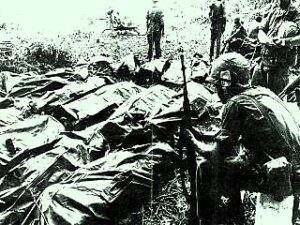
Arriving with the Army's CH47 helicopters on Tuesday morning was the only operable Huskie from Detachment 6. The PJ on board was one of the Pits' closest friends, Harry O'Berne. The Huskie was the first chopper to land and O'Berne moved among the dead to find and load three wounded infantrymen. Then, as the Huskie lifted off, O'Berne remained on the ground to treat wounded and load them on the Army Chinook. As he moved among the bodies that littered the jungle floor, an Army captain approached and asked if he was a medic. O'Berne replied that he was. "I'm sorry but one of your buddies was killed last night," he informed the PJ, then pointed towards a poncho covered bundle in the distance.
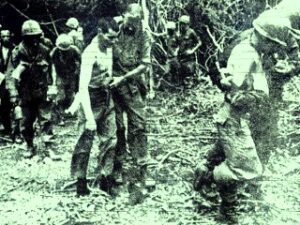
Slowly, O'Berne approached to gently lift the poncho. Beneath was the body of his friend, Pararescue medic William Pitsenbarger...shot four times. In one lifeless hand Pits still held his M-16 rifle. In the other, he still clutched his medical kit.
Within days of that horrible night, Sergeant Fred Navarro provided the Air Force with a taped statement detailing the heroism of Airman First Class William Pitsenbarger in support of a recommendation for the Medal of Honor. Few witnesses remained of the young PJs service and sacrifice. Of the 134 soldiers in Charlie Company at the beginning of Operation Abilene, there were 106 casualties. Only two members of Sergeant Navarro's 10-man squad had survived.
Army Staff Sergeant James Robinson was submitted for the Medal of Honor for his heroic sacrifice during Operation Abilene. His posthumous award was presented to his father at the Pentagon in ceremonies on July 16, 1967. The recommendation for William Pitsenbarger's Medal of Honor was downgraded to the Air Force Cross. When Mr. and Mrs. Pitsenbarger accepted that award on behalf of their heroic son on September 22, 1966, William Pits Pitsenbarger became the first enlisted airman in history to receive the Air Force's second-highest award for military heroism, posthumously.
Twelve members of the United States Air Force received Medals of Honor for heroic actions in Vietnam. Just one month prior to the Easter Sunday beginning of Operation Abilene, Major Bernard Francis Fisher became the first person to earn the newly designed Air Force Medal of Honor. (During the Korean War, four Air Force pilots were posthumously awarded the Medal of Honor but all received the Army design for the award.)
Four years after William Pitsenbarger's death, Airman First Class John Lee Levitow became the first and only enlisted airman to receive our Nation's highest military award.
William Pitsenbarger's story survived for more than three decades, making the young airman something of an Air Force legend. In the 1990s, a campaign was initiated by numerous private citizens as well as federal officials, to revisit the story of the boy from Piqua, Ohio. The subsequent review determined that the level of voluntary heroism displayed by the 21-year old PJ in the jungles of Vietnam was more in keeping with the levels of valor reflected by the Medal of Honor.
On December 8, 2000, an impressive ceremony was held at Wright-Patterson AFB in Pits' home state of Ohio. The guest list included combat veterans, hundreds of pararescue airmen, a Congressional representative, and the Air Force Chief of Staff. Also attending was an elderly gentleman, now well into his 80s...William F. Pitsenbarger. Amid a flood of memories, an invocation by the Chief of the Air Force Chaplain Service, and remarks by the Chief Master Sergeant of the Air Force, Secretary of the Air Force the Honorable F. Whitten Peters stepped to the podium. Then, with the dignity unprecedented valor demands, the story of William Pitsenbarger was read in greater detail than his Air Force Cross citation had set forth. At long last, after 34 years, the young PJ would indeed receive the Medal of Honor. The elder Pitsenbarger gratefully accepted the award on behalf of his only son.
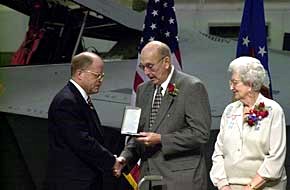
About the Author
Jim Fausone is a partner with Legal Help For Veterans, PLLC, with over twenty years of experience helping veterans apply for service-connected disability benefits and starting their claims, appealing VA decisions, and filing claims for an increased disability rating so veterans can receive a higher level of benefits.
If you were denied service connection or benefits for any service-connected disease, our firm can help. We can also put you and your family in touch with other critical resources to ensure you receive the treatment you deserve.
Give us a call at (800) 693-4800 or visit us online at www.LegalHelpForVeterans.com.
This electronic book is available for free download and printing from www.homeofheroes.com. You may print and distribute in quantity for all non-profit, and educational purposes.
Copyright © 2018 by Legal Help for Veterans, PLLC
ALL RIGHTS RESERVED



